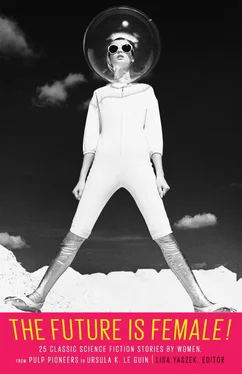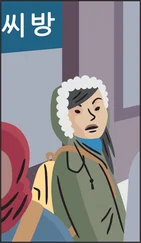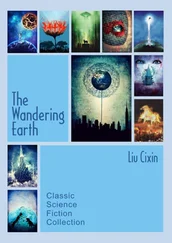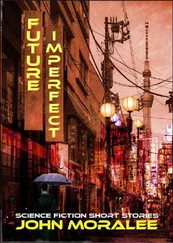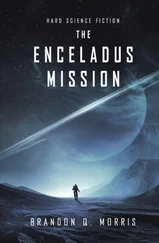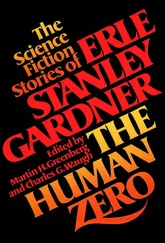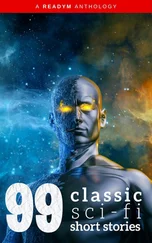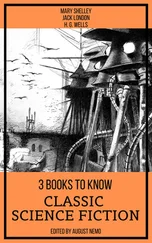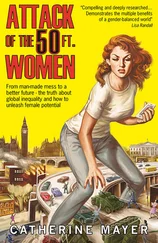A drop of three hundred feet showed me inert specks of humanity lying about the streets. Then I knew; the oxygen plant was not in operation! In another minute I had on my oxygen mask, which was attached to a small portable tank for emergency use, and I rushed for the vicinity of the plant. There I witnessed the first signs of life. Men equipped with oxygen masks, were trying to force entrance into the locked building. Being an employee, I possessed knowledge of the combination of the great lock, and I opened the door, only to be greeted by a swarm of ants that commenced a concerted attack upon us.
The floor seemed to be covered with a moving black rug, the corner nearest the door appearing to unravel as we entered, and it was but a few seconds before we were covered with the clinging, biting creatures, who fought with a supernatural energy born of despair. Two very active ants succeeded in getting under my helmet. The bite of their sharp mandibles and the effect of their poisonous formic acid became intolerable. Did I dare remove my mask while the air about me was foul with the gas discharged from the weapons of my allies? While I felt the attacks elsewhere upon my body gradually diminishing as the insects succumbed to the deadly fumes, the two upon my face waxed more vicious under the protection of my mask. One at each eye, they were trying to blind me. The pain was unbearable. Better the suffocating death-gas than the torture of lacerated eyes! Frantically I removed the head-gear and tore at the shiny black fiends. Strange to tell, I discovered that I could breathe near the vicinity of the great oxygen tanks, where enough oxygen lingered to support life at least temporarily. The two vicious insects, no longer protected by my gas-mask, scurried from me like rats from a sinking ship and disappeared behind the oxygen tanks.
This attack of our enemies, though unsuccessful on their part, was dire in its significance, for it had shown more cunning and ingenuity than anything that had ever preceded it. Heretofore, their onslaughts had been confined to direct attacks upon us personally or upon the synthetic-food laboratories, but in this last raid they had shown an amazing cleverness that portended future disaster, unless they were checked at once. It was obvious they had ingeniously planned to smother us by the suspension of work at the oxygen plant, knowing that they themselves could exist in an atmosphere containing a greater percentage of carbon-dioxide. Their scheme, then, was to raid our laboratories for food.
III. Lucanus the Last
A Continuation of Delfair’s Account.
Although it was evident that the cessation of all plant-life spelled inevitable doom for the insect inhabitants of Earth, their extermination did not follow as rapidly as one might have supposed. There were years of internecine warfare. The insects continued to thrive, though in decreasing numbers, upon stolen laboratory foods, bodies of human-beings and finally upon each other; at first capturing enemy species and at last even resorting to a cannibalistic procedure. Their rapacity grew in inverse proportion to their waning numbers, until the meeting of even an isolated insect might mean death, unless one were equipped with poison gas and prepared to use it upon a second’s notice.
I am an old man now, though I have not yet lived quite two centuries, but I am happy in the knowledge that I have lived to see the last living insect which was held in captivity. It was an excellent specimen of the stag-beetle ( Lucanus ) and the years have testified that it was the sole survivor of a form of life that might have succeeded man upon this planet. This beetle was caught weeks after we had previously seen what was supposed to be the last living thing upon the globe, barring man and the sea-life. Untiring search for years has failed to reveal any more insects, so that at last man rests secure in the knowledge that he is monarch of all he surveys.
I have heard that long, long ago man used to gaze with a fearful fascination upon the reptilian creatures which he displaced, and just so did he view this lone specimen of a type of life that might have covered the face of the earth, but for man’s ingenuity.
It was this unholy lure that drew me one day to view the captive beetle in his cage in district 404 at Universapolis. I was amazed at the size of the creature, for it looked larger than when I had seen it by television, [1] In the notes below, the reference numbers denote page and line of the hardcover edition (the line count includes headings but not blank lines). For further information about the authors in this volume and women’s SF during this period, along with references to other studies, see Brian Attebery, Decoding Gender in Science Fiction (2002); Eric Leif Davin, Partners in Wonder: Women and the Birth of Science Fiction, 1926–1965 (2005); Jane Donawerth, Frankenstein’s Daughters: Women Writing Science Fiction (1997); Justine Larbalestier, The Battle of the Sexes in Science Fiction (2002), and Daughters of Earth: Feminist Science Fiction in the Twentieth Century (2006); Helen Merrick, The Secret Feminist Cabal: A Cultural History of Science Fiction Feminisms (2010); Robin Roberts, A New Species: Gender and Science in Science Fiction (1993); Lisa Yaszek, Galactic Suburbia: Recovering Women’s Science Fiction (2008); and Lisa Yaszek and Patrick B. Sharp, eds., Sisters of Tomorrow: The First Women of Science Fiction (2016).
, [2] 9.6 The first television broadcast experiments were taking place in both Europe and the United States around the time “The Miracle of the Lily” was published in Hugo Gernsback’s Amazing Stories in April 1928; Gernsback himself began regular “radio television” broadcasts from his New York radio station WRNY in August 1928.
but I reasoned that upon that occasion there had been no object near with which to compare its size. True, the broadcaster had announced its dimensions, but the statistics concretely given had failed to register a perfect realization of its prodigious proportions.
As I approached the cage, the creature was lying with its dorsal covering toward me and I judged it measured fourteen inches from one extremity to the other. Its smooth horny sheath gleamed in the bright artificial light. (It was confined on the third level.) As I stood there, mentally conjuring a picture of a world overrun with billions of such creatures as the one before me, the keeper approached the cage with a meal-portion of synthetic food. Although the food has no odor, the beetle sensed the man’s approach, for it rose on its jointed legs and came toward us, its horn-like prongs moving threateningly; then apparently remembering its confinement, and the impotency of an attack, it subsided and quickly ate the food which had been placed within its prison.
The food consumed, it lifted itself to its hind legs, partially supported by a box, and turned its great eyes upon me. I had never been regarded with such utter malevolence before. The detestation was almost tangible and I shuddered involuntarily. As plainly as if he spoke, I knew that Lucanus was perfectly cognizant of the situation and in his gaze I read the concentrated hate of an entire defeated race.
I had no desire to gloat over his misfortune, rather a great pity toward him welled up within me. I pictured myself alone, the last of my kind, held up for ridicule before the swarming hordes of insects who had conquered my people, and I knew that life would no longer be worth the living.
Whether he sensed my pity or not I do not know, but he continued to survey me with unmitigated rage, as if he would convey to me the information that his was an implacable hatred that would outlast eternity.
Not long after this he died, and a world long since intolerant of ceremony, surprised itself by interring the beetle’s remains in a golden casket, accompanied by much pomp and splendor.
Читать дальше
